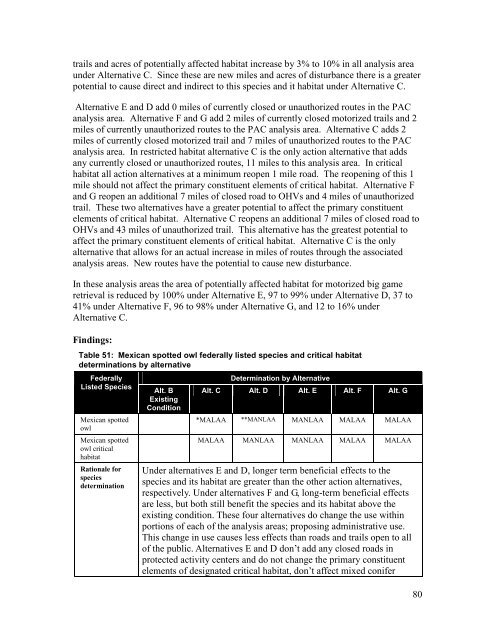Wildlife Specialist report
Wildlife Specialist report
Wildlife Specialist report
You also want an ePaper? Increase the reach of your titles
YUMPU automatically turns print PDFs into web optimized ePapers that Google loves.
trails and acres of potentially affected habitat increase by 3% to 10% in all analysis area<br />
under Alternative C. Since these are new miles and acres of disturbance there is a greater<br />
potential to cause direct and indirect to this species and it habitat under Alternative C.<br />
Alternative E and D add 0 miles of currently closed or unauthorized routes in the PAC<br />
analysis area. Alternative F and G add 2 miles of currently closed motorized trails and 2<br />
miles of currently unauthorized routes to the PAC analysis area. Alternative C adds 2<br />
miles of currently closed motorized trail and 7 miles of unauthorized routes to the PAC<br />
analysis area. In restricted habitat alternative C is the only action alternative that adds<br />
any currently closed or unauthorized routes, 11 miles to this analysis area. In critical<br />
habitat all action alternatives at a minimum reopen 1 mile road. The reopening of this 1<br />
mile should not affect the primary constituent elements of critical habitat. Alternative F<br />
and G reopen an additional 7 miles of closed road to OHVs and 4 miles of unauthorized<br />
trail. These two alternatives have a greater potential to affect the primary constituent<br />
elements of critical habitat. Alternative C reopens an additional 7 miles of closed road to<br />
OHVs and 43 miles of unauthorized trail. This alternative has the greatest potential to<br />
affect the primary constituent elements of critical habitat. Alternative C is the only<br />
alternative that allows for an actual increase in miles of routes through the associated<br />
analysis areas. New routes have the potential to cause new disturbance.<br />
In these analysis areas the area of potentially affected habitat for motorized big game<br />
retrieval is reduced by 100% under Alternative E, 97 to 99% under Alternative D, 37 to<br />
41% under Alternative F, 96 to 98% under Alternative G, and 12 to 16% under<br />
Alternative C.<br />
Findings:<br />
Table 51: Mexican spotted owl federally listed species and critical habitat<br />
determinations by alternative<br />
Federally<br />
Listed Species<br />
Mexican spotted<br />
owl<br />
Mexican spotted<br />
owl critical<br />
habitat<br />
Rationale for<br />
species<br />
determination<br />
Alt. B<br />
Existing<br />
Condition<br />
Determination by Alternative<br />
Alt. C Alt. D Alt. E Alt. F Alt. G<br />
*MALAA **MANLAA MANLAA MALAA MALAA<br />
MALAA MANLAA MANLAA MALAA MALAA<br />
Under alternatives E and D, longer term beneficial effects to the<br />
species and its habitat are greater than the other action alternatives,<br />
respectively. Under alternatives F and G, long-term beneficial effects<br />
are less, but both still benefit the species and its habitat above the<br />
existing condition. These four alternatives do change the use within<br />
portions of each of the analysis areas; proposing administrative use.<br />
This change in use causes less effects than roads and trails open to all<br />
of the public. Alternatives E and D don’t add any closed roads in<br />
protected activity centers and do not change the primary constituent<br />
elements of designated critical habitat, don’t affect mixed conifer<br />
80
















